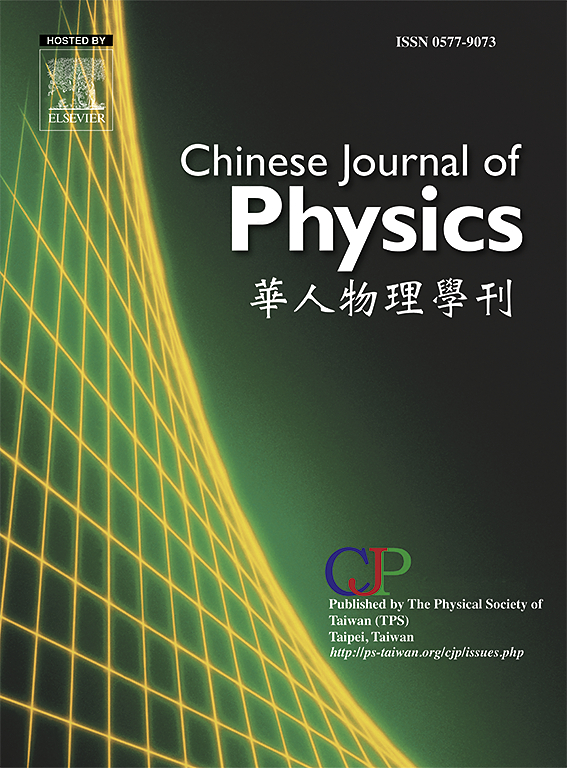A novel piecewise unsaturated asymmetric coupled tri-stable stochastic resonance method and its application in enhanced detection
IF 4.6
2区 物理与天体物理
Q1 PHYSICS, MULTIDISCIPLINARY
引用次数: 0
Abstract
Stochastic resonance (SR) has been extensively explored as an effective technique for weak signal detection, relying on the principle of enhancing weak signal components through the introduction of an appropriate amount of noise to improve signal detectability. To address the output saturation issue of classical tri-stable stochastic resonance (CTSR) system, we introduce a novel piecewise unsaturated asymmetric coupled tri-stable stochastic resonance (PUACTSR) system, incorporating three improvements: unsaturation, asymmetry and coupling. First, the steady-state probability density (SPD) and the power spectral amplification factor (SA) are derived using adiabatic approximation theory, and the effects of system parameters on performance are analyzed. Second, the signal-to-noise ratio gain (SNRG) is utilized as an index to assess the system’s enhancement. Numerical simulations and detection of simulated periodic signals demonstrate that the PUACTSR system outperforms both the CTSR and piecewise unsaturated asymmetric time-delayed tri-stable stochastic resonance (PUATDTSR) systems. Finally, the proposed method employs a quantum genetic algorithm (QGA) for parameter optimization, effectively eliminating the randomness and low accuracy associated with manual tuning in computational settings. The results show that for detecting outer-ring fault signals, the PUACTSR system achieves a 0.14 dB improvement over the PUATDTSR system, a 2.31 dB improvement over the symmetric case, and a 4.76 dB improvement over the CTSR system. Furthermore, the power spectral curves show reduced noise interference, demonstrating superior detection performance compared to the other systems. This study highlights the theoretical significance of the PUACTSR system for bearing fault diagnosis and its potential for practical engineering applications.

一种新的分段不饱和不对称耦合三稳定随机共振方法及其在增强检测中的应用
随机共振(random resonance, SR)是一种有效的微弱信号检测技术,其原理是通过引入适量的噪声来增强微弱信号的分量,从而提高信号的可检测性。为了解决经典三稳定随机共振(CTSR)系统的输出饱和问题,提出了一种新的分段不饱和不对称耦合三稳定随机共振(PUACTSR)系统,该系统进行了不饱和、不对称和耦合三个方面的改进。首先,利用绝热近似理论推导了稳态概率密度(SPD)和功率谱放大因子(SA),并分析了系统参数对性能的影响。其次,利用信噪比增益(SNRG)作为评价系统增强的指标。数值模拟和模拟周期信号检测表明,PUACTSR系统优于CTSR和分段不饱和不对称时滞三稳定随机共振(PUATDTSR)系统。最后,该方法采用量子遗传算法(QGA)进行参数优化,有效地消除了计算设置中人工调优的随机性和低精度。结果表明,对于检测外环故障信号,PUACTSR系统比PUATDTSR系统提高了0.14 dB,比对称情况提高了2.31 dB,比CTSR系统提高了4.76 dB。此外,功率谱曲线显示噪声干扰减少,与其他系统相比显示出优越的检测性能。本研究突出了PUACTSR系统在轴承故障诊断中的理论意义及其在实际工程应用中的潜力。
本文章由计算机程序翻译,如有差异,请以英文原文为准。
求助全文
约1分钟内获得全文
求助全文
来源期刊

Chinese Journal of Physics
物理-物理:综合
CiteScore
8.50
自引率
10.00%
发文量
361
审稿时长
44 days
期刊介绍:
The Chinese Journal of Physics publishes important advances in various branches in physics, including statistical and biophysical physics, condensed matter physics, atomic/molecular physics, optics, particle physics and nuclear physics.
The editors welcome manuscripts on:
-General Physics: Statistical and Quantum Mechanics, etc.-
Gravitation and Astrophysics-
Elementary Particles and Fields-
Nuclear Physics-
Atomic, Molecular, and Optical Physics-
Quantum Information and Quantum Computation-
Fluid Dynamics, Nonlinear Dynamics, Chaos, and Complex Networks-
Plasma and Beam Physics-
Condensed Matter: Structure, etc.-
Condensed Matter: Electronic Properties, etc.-
Polymer, Soft Matter, Biological, and Interdisciplinary Physics.
CJP publishes regular research papers, feature articles and review papers.
 求助内容:
求助内容: 应助结果提醒方式:
应助结果提醒方式:


